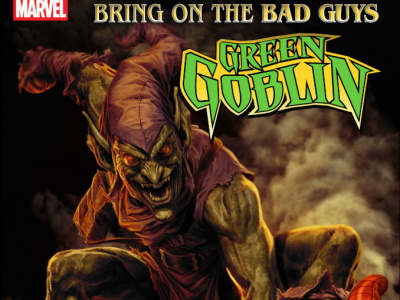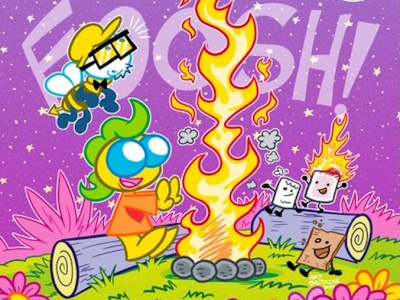
Lance Fensterman, the Reed Exhibitions VP in charge of New York Comic Con, told us he’s expecting “fairly significant growth” for the show this year in its earlier dates of February 6-8. We caught up with Fensterman late last week to ask about expectations for the show, the impact of the earlier dates, and other changes for this year’s event.
The show’s over two months earlier than it was last year. What does that mean for the show?
It means we’re crossing our fingers a little bit about the weather. We always worry about that this time of year. We’ve arranged to have queuing halls for all the fans so nobody’s going to be standing outside--they’ll be inside where it’s nice and warm.
It also means we’re very close to Toy Fair, which affects some of our toy companies.
On the flip side it really means that we’re the first con of the year and we’re kickin’ everything off.
Like any other decision or choice that you have, there are ups and downs. We’ll do our best to mitigate the downs and accentuate the ups.
It’s only a month away. What’s the status of registration cut-offs, that kind of thing?
Things are looking very good for the show. We’ve got our guests pretty solidified; there will be a few more announcements coming out. Our exhibit floor is looking strong; we’ll have growth over last year. The ticket sales are a little bit behind right now in percentages, not so much in quantity. We attribute that to the holidays, to be honest with you.
We’re coming up on some deadlines here where we’ll have all of our panels announced most likely next week, which will be big. Then on the sixteenth we have a deadline for getting tickets mailed out to fans.
In the next two weeks I expect to see a fair amount of ticket sales happening. We’re getting close. Thirty-one days I believe.
Are you going to have more, less, or about the same number of programs this year as last year?
In terms of panels we’re trimming things back a little bit. We felt last year we had amazing programming but more than we needed. You saw that it was really stretching us to the max. At one point we had to shut down some of the conference area because of the sheer crowds. We felt like it was prudent to trim about fifteen per cent in terms of the number of panels, with a focus on quality, on spacing the panels out a little bit more, and staggering start times just to deal with those logistics. Since year one, we’ve always worked hard to improve our logistics every year. We set the bar maybe low logistically in year one but we have been improving it every year.
In terms of that crowding question, what’s the over-all space the show is going to have this year versus last year. Is that up, down, or about the same?
It’s actually up about twenty per cent. We have the same halls for the exhibit floor but our panel rooms will now be directly below the exhibit floor. Last year they were on the other end of the building. That does two things. One, it’s more convenient for our fans. Two, that space down there is actually larger than at the other end of the building by roughly fifteen thousand square feet. In addition to that we’ve added the Galleria, which is up above the show floor, which we had two years ago. We used that space for Artists Alley. We won’t be using it for Artists Alley, but that is an additional sixty thousand square feet that we’ve added to the show. There’s significant growth in terms of room to move around and room for exhibits, activities, and panels.
All those things put together, do you have expectations for where attendance is going to end up this year? The economy is sort of a back-drop for all of this and that makes everything kind of tough to plan for.
My expectation is for a fairly significant growth on the attendee side. I feel like the show is growing in stature, and this show will grow in size. I can say with some certainty we’ve reached a new audience, that next tier out from the hard-core fans to the maybe less hard-core, more casual fans. That was all accomplished last year and I wouldn’t expect that to change dramatically. However, you said it: the economy is obviously a question. Our goal is to create value, to create an amazing event. I feel like if we do that our fans will reward us. They’ll spend their last fifty bucks with us on a ticket. I believe we’ve created a show that would warrant that commitment.
We’ve been reporting on your guest line-up. How do you decide between Guest of Honor and Featured Guest?
A lot of it is the time they’re able to commit. It’s not so much about status as it’s about a type of guest, if you will. Typically when we have a Guest of Honor, they’ve said to us, “Yes, we can be there all three days; yes, we will be accessible to the fans at every turn possible; we’re all in.” Where some guests might say, “I can come in and do a panel but then I gotta jet.” So we call them “Featured,” but if it’s a Guest of Honor they’re making a very large commitment to New York Comic Con and to the fans. It’s our promise to the fans: if there’s a Guest of Honor coming, you’re going to have a chance to meet them. You’re going to have a chance to get an autograph, to attend a panel, to see them do a talk. With a Featured Guest they might not have that exposure. It’s really kind of a logistical distinction more than it is an honorary distinction.
What’s going on with trade programming this year?
We are excited to have the ICv2 Conference back. I’m sucking up here, but you always do a nice job and that is obviously a great, robust amount of programming.
We’ve got a little bit less trade programming than we have in the past. We’re trying to focus a little bit more. We’re doing some things with ComicsPro that we’re really pleased with. I’m working on my little secret project which I hope will be a trade keynote panel that will have some industry luminaries. I can’t bat around names because I’m still working on it. The goal would be to have one sort of trademark high-profile panel that would sort of cap off our day of trade programming. Other than that we have a lot of that kind of core stuff that needs to be covered for the retailers, for trends and industry happenings.
Any other changes for this year that you want to get out there?
Actually we’re very close to rolling out a cool, new navigation tool online that I’m proud of. We do a lot of fan-focus groups, asking them what they want. And a you know, I’m pretty accessible to fans. They’ve all got my e-mail addresses if they want to tell me something. What we heard a lot of was, “Help me plan my time at the show. Help me get around. Help me figure out what’s where. I don’t want to plan on going to two panels that are at the other end of the building and they’re fifteen minutes apart.”
We’ve created something called “I-Con,” or Interactive Con. It literally is an interactive floor plan of the entire building. It also has a listing of every single panel and everything that’s going on so that you can add them to a planner. You can really lay out your entire con experience which I think is cool. It was something that our fans told us they wanted and we’ve done for them.
We’re also seeing really significant growth in the gaming segment. Lots and lots of video game companies are coming out this year. We’re working on getting a comprehensive list going but it looks like twenty-five, twenty-eight different titles are going to be represented at the show with previews happening and things like that.
Lastly, TV is coming out in a big way. We saw
So all that’s pretty cool stuff. I’m excited about it.







